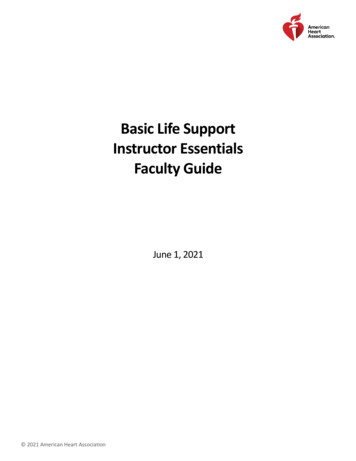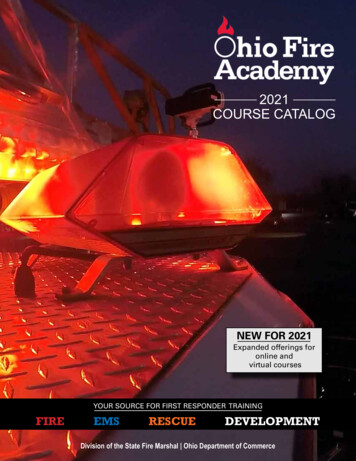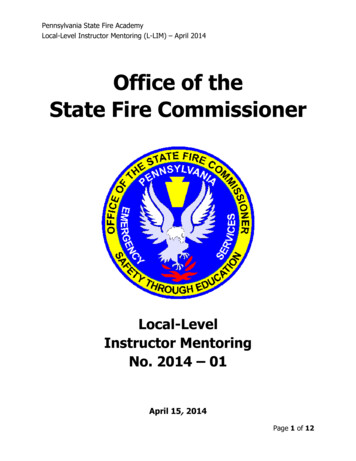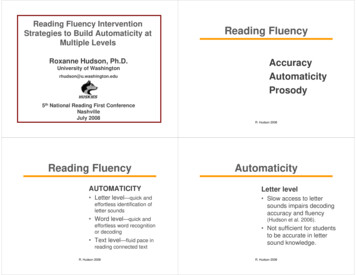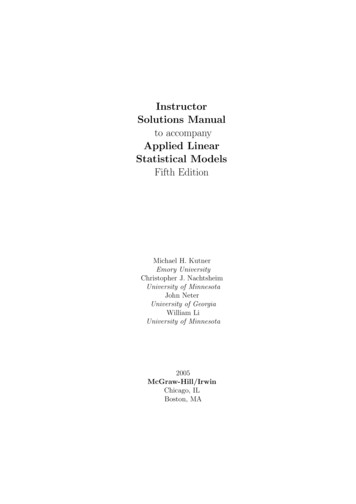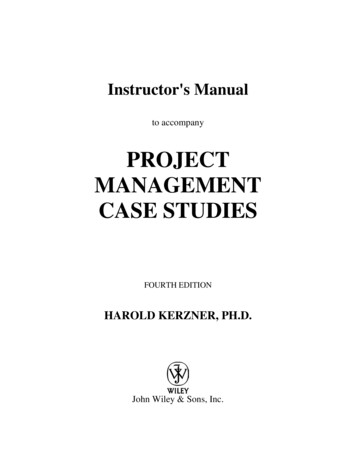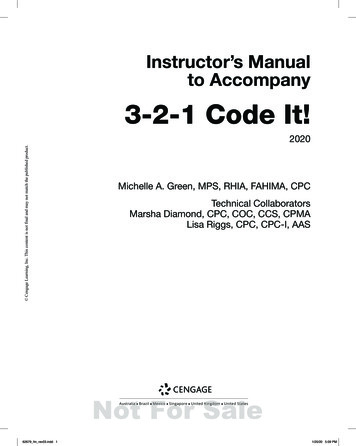
Transcription
Instructor’s Manualto Accompany3-2-1 Code It! Cengage Learning, Inc. This content is not final and may not match the published product.2020Michelle A. Green, MPS, RHIA, FAHIMA, CPCTechnical CollaboratorsMarsha Diamond, CPC, COC, CCS, CPMALisa Riggs, CPC, CPC-I, AASNot For SaleAustralia62679 fm rev03.indd 1 Brazil# 110730 Cust: Cengage Au: Green Pg. No. i Mexico Singapore United Kingdom United StatesKDESIGN SERVICES OF1/20/20 5:09 PM
Not For SaleMichelle A. GreenSVP, Higher Education & Skills Product:Erin JoynerProduct Director: Matthew SeeleySenior Product Manager: Stephen G. SmithProduct Assistant: Dallas WilkesDirector, Learning Design: Rebecca von GillernSenior Manager, Learning Design:Leigh HefferonLearning Designer: Kaitlin SchlichtMarketing Director: Sean H. ChamberlandDirector, Content Creation: Juliet SteinerContent Creation Manager: Stacey LamodiSenior Content Manager: Kara A. DiCaterinoDigital Delivery Lead: Lisa ChristopherSenior Designer, Creative Studio:Angela Sheehan 2021, 2020, Cengage Learning, Inc.ALL RIGHTS RESERVED. No part of this work covered by the copyright hereinmay be reproduced or distributed in any form or by any means, except aspermitted by U.S. copyright law, without the prior written permission of thecopyright owner.The 2020 versions of CPT, HCPCS Level II, ICD-10-CM, and ICD-10-PCS wereused in preparation of this product.CPT publications are published by the American Medical Association and CPTis a registered trademark of the American Medical Association. The AmericanMedical Association is not affiliated with Cengage and has not sponsored,endorsed, or licensed this publication.For product information and technology assistance, contact us atCengage Customer & Sales Support, 1-800-354-9706 orsupport.cengage.com.For permission to use material from this text or product, submit allrequests online at www.cengage.com/permissions.Instructor Companion Site: 978-0-357-36267-9Core ISBN: 978-0-357-36264-8Cengage200 Pier 4 BoulevardBoston, MA 02210USACengage is a leading provider of customized learning solutionswith employees residing in nearly 40 different countries and sales in morethan 125 countries around the world. Find your local representativeat: www.cengage.com.Cengage products are represented in Canada by Nelson Education, Ltd.To learn more about Cengage platforms and services, register or access youronline learning solution, or purchase materials for your course, visitwww.cengage.com.Notice to the ReaderPublisher does not warrant or guarantee any of the products described herein or perform anyindependent analysis in connection with any of the product information contained herein. Publisher does not assume, and expressly disclaims, any obligation to obtain and include informationother than that provided to it by the manufacturer. The reader is expressly warned to considerand adopt all safety precautions that might be indicated by the activities described herein andto avoid all potential hazards. By following the instructions contained herein, the reader willinglyassumes all risks in connection with such instructions. The publisher makes no representations orwarranties of any kind, including but not limited to, the warranties of fitness for particular purposeor merchantability, nor are any such representations implied with respect to the material set forthherein, and the publisher takes no responsibility with respect to such material. The publisher shallnot be liable for any special, consequential, or exemplary damages resulting, in whole or part, fromthe readers’ use of, or reliance upon, this material.62679 fm rev03.indd 2# 110730 Cust: CengageAu: Green Pg. No. iiKDESIGN SERVICES OF Cengage Learning, Inc. This content is not final and may not match the published product.Instructor’s Manual to Accompany3-2-1 Code It! 20201/20/20 5:09 PM
Cengage Learning, Inc. This content is not final and may not match the published product.ContentsPREFACE vSECTION IPreparing Your Course1SECTION IIAnswer Keys to Chapter Exercises and ReviewsChapter 1 – Overview of CodingChapter 2 – Introduction to ICD-10-CM and ICD-10-PCS CodingChapter 3 – ICD-10-CM and ICD-10-PCS Coding ConventionsChapter 4 – Chapter-Specific Coding Guidelines: ICD-10-CM Chapters 1–10 Chapter 5 – Chapter-Specific Coding Guidelines: ICD-10-CM Chapters 11–21Chapter 6 – ICD-10-CM and ICD-10-PCS Hospital Inpatient CodingChapter 7 – ICD-10-CM Outpatient and Physician Office CodingChapter 8 – HCPCS Level II Coding SystemChapter 9 – Introduction to CPT CodingChapter 10 – CPT Evaluation and ManagementChapter 11 – CPT AnesthesiaChapter 12 – CPT Surgery IChapter 13 – CPT Surgery IIChapter 14 – CPT Surgery IIIChapter 15 – CPT Surgery IVChapter 16 – CPT Surgery VChapter 17 – CPT RadiologyChapter 18 – CPT Pathology and LaboratoryChapter 19 – CPT MedicineChapter 20 – Insurance and 7120125127SECTION IIIAnswer Keys to Workbook Assignments and Reviews129SEMESTER PLANSADMINISTERING EXAMSGRADING ASSIGNMENTS AND EXAMSLESSON PLANS3555Chapter 1 – Overview of CodingChapter 2 – Introduction to ICD-10-CM and ICD-10-PCS CodingChapter 3 – ICD-10-CM and ICD-10-PCS Coding ConventionsChapter 4 – Chapter-Specific Coding Guidelines: ICD-10-CM Chapters 1–10 Chapter 5 – Chapter-Specific Coding Guidelines: ICD-10-CM Chapters 11–21 Chapter 6 – ICD-10-CM and ICD-10-PCS Hospital Inpatient CodingChapter 7 – ICD-10-CM Outpatient and Physician Office CodingChapter 8 – HCPCS Level II Coding SystemChapter 9 – Introduction to CPT CodingChapter 10 – CPT Evaluation and ManagementChapter 11 – CPT AnesthesiaChapter 12 – CPT Surgery IChapter 13 – CPT Surgery IIChapter 14 – CPT Surgery IIIChapter 15 – CPT Surgery IVNot For 4iii 2021 Cengage Learning, Inc. May not be scanned, copied or duplicated, or posted to a publicly accessible website, in whole or in part. 62679 fm rev03.indd 3# 110730 Cust: Cengage Au: Green Pg. No. iiiKDESIGN SERVICES OF1/20/20 5:09 PM
Not For SaleChapter 16 – CPT Surgery VChapter 17 – CPT RadiologyChapter 18 – CPT Pathology and LaboratoryChapter 19 – CPT MedicineChapter 20 – Insurance and Reimbursement219225228232235SECTION IVAnswer Keys to Workbook Coding Cases241SECTION VAnswer Key to Workbook Appendix E: Mock CertifiedProfessional Coder (CPC) Certification Examination253SECTION VIAnswer Key to Workbook Appendix F: Mock CertifiedCoding Specialist—Physicianbased (CCS-P) CertificationExamination 255SECTION VIIAnswer Key to Workbook Appendix G: Mock CertifiedCoding Specialist (CCS) Certification ExaminationAmbulatory Surgery Unit Coding Cases Answer Key (for Workbook Appendix A)Emergency Department Coding Cases Answer Key (for Workbook Appendix B)Physician Office Coding Cases Answer Key (for Workbook Appendix C)Inpatient Coding Cases Answer Key (for Workbook Appendix D)242245247250261 Cengage Learning, Inc. This content is not final and may not match the published product.iv Contents 2021 Cengage Learning, Inc. May not be scanned, copied or duplicated, or posted to a publicly accessible website, in whole or in part. 62679 fm rev03.indd 4# 110730 Cust: CengageAu: Green Pg. No. ivKDESIGN SERVICES OF1/20/20 5:09 PM
PrefaceThis Instructor’s Manual is organized into seven sections: Section I: Preparing Your Course Cengage Learning, Inc. This content is not final and may not match the published product.Note:Section I contains sample semester plans and policies for administering exams and gradingassignments and exams. Chapter lesson plans that can be modified for individual use areincluded. Section II: Answer Keys to Chapter Exercises and Reviews Section III: Answer Keys to Workbook Assignments and ReviewsNote:Sections II and III are organized according to chapter. Section IV: Answer Keys to Workbook Appendices A–D: Coding Patient RecordsAnswer Key to Appendix A: Coding Ambulatory Care Surgery Patient RecordsAnswer Key to Appendix B: Coding Emergency Department Patient RecordsAnswer Key to Appendix C: Coding Physician Office RecordsAnswer Key to Appendix D: Coding Hospital Inpatient Records Section V: Answer Key to Workbook Appendix E: Mock Certified Professional Coder (CPC) CertificationExaminationSection VI: Answer Key to Workbook Appendix F: Mock Certification Coding Specialist-Physician (CCS-P)Certification ExaminationSection VII: Answer Key to Workbook Appendix G: Mock Certified Coding Specialist (CCS) CertificationExaminationTeaching Tip:Consider placing a sticky note as a tab at the beginning of each section in the Instructor’sManual.Not For Salev 2021 Cengage Learning, Inc. May not be scanned, copied or duplicated, or posted to a publicly accessible website, in whole or in part. 62679 fm rev03.indd 5# 110730 Cust: Cengage Au: Green Pg. No. vKDESIGN SERVICES OF1/20/20 5:09 PM
vi Preface Not For SaleStudent WorkbookThe workbook follows the chapter organization of the core textbook and contains application-based assignments.Each assignment contains a list of objectives, an overview of content relating to the assignment, and instructionsfor completing the assignment. The last assignment in each workbook chapter contains review questions inmultiple-choice format to emulate credentialing exam questions. The workbook also contains actual patientrecords and mock CPC, CCS-P, and CCS certification examinations.EncoderPro.com Expert Using online coding tools can help by saving you time and money; Increasing accuracy, reducing denials, and ensuring you receive complete reimbursement; and Reducing required storage space and paper.Features of EncoderPro.com Expert include: ICD-10-CM/PCS, HCPCS level II, and CPT code content search ICD-10 mapping tools Coders' Desk Reference Complete code history Local Coverage Determinations (LCDs) and Medicare Pub. 100 access Medicare CCI edits Modifier crosswalk Enhanced compliance editor Enhanced LCD/NCD policy searching Cross-coder relationships from seven coding and billing specialty reference booksTo make the switch and start saving on coding materials with Cengage and Optum360 , contact your CengageLearning Consultant today at cengage.com/repfinder.Instructor Companion SITEAdditional resources can be found online at http://login.cengage.com.Items listed as Instructor Resources are password-protected. To access the protected Instructor Resources, go tohttp://login.cengage.com to create a unique single-user sign-on. Contact your sales representative for more information. Cengage Learning, Inc. This content is not final and may not match the published product.Enhance your course with Cengage learning materials and an online coding tool from Optum360 .EncoderPro.com Expert is an online coding and reference tool designed to enhance your coding capabilities.Note:Login instructions for Student Resources listed on the Student Companion Site are located inthe textbook Preface.Teaching Tip:The Instructor and Student Companion Sites also include files that contain updates tothe textbook and its supplements, which were changes made to the textbook, workbook,instructor’s manual, and/or computerized test bank after publication (e.g., revised codes due tocoding updates). You are welcome to email the author at michelle.ann.green@gmail.com withquestions or comments. The author will respond to your emails, and appropriate corrections willbe posted to provide clarification about the textbook and its supplements. 2021 Cengage Learning, Inc. May not be scanned, copied or duplicated, or posted to a publicly accessible website, in whole or in part. 62679 fm rev03.indd 6# 110730 Cust: CengageAu: Green Pg. No. viKDESIGN SERVICES OF1/20/20 5:09 PM
Preface viiINSTRUCTOR RESOURCESIn addition to this electronic version of the Instructor’s Manual, the Instructor Resources contain an onlinecomputerized testbank powered by Cognero, and instructor’s slides created in PowerPoint . These supplementsare located at the password-protected Instructor Companion Site at http://login.cengage.com.Teaching Tip: Cengage Learning, Inc. This content is not final and may not match the published product.The Cognero testbank contains multiple choice and completion (coding) questions. Cognerosoftware is available on the Instructor Companion Site to allow you to generate examsquickly, which can be printed, exported and uploaded to a learning management system(e.g., Blackboard), or web-enabled. This means that you can create different versions of thesame exam for large classes of students (when students cannot be separated from each otherby an empty desk). To save you some time, exported files for Blackboard, Moodle, Angel,Desire2Learn, and Canvas can be downloaded directly from the Instructor Companion Site.Not For Sale 2021 Cengage Learning, Inc. May not be scanned, copied or duplicated, or posted to a publicly accessible website, in whole or in part. 62679 fm rev03.indd 7# 110730 Cust: Cengage Au: Green Pg. No. viiKDESIGN SERVICES OF1/20/20 5:09 PM
Cengage Learning, Inc. This content is not final and may not match the published product.Not For Sale62679 fm rev03.indd 81/20/20 5:09 PM
SECTION Cengage Learning, Inc. This content is not final and may not match the published product.iPreparing Your CourseNot For Sale 2021 Cengage Learning, Inc. May not be scanned, copied or duplicated, or posted to a publicly accessible website, in whole or in part. 62679 sec01 rev04.indd 11/17/20 4:00 PM
2 SECTION INot For Sale3-2-1 Code It! is a comprehensive textbook that covers all coding systems, and its content is written toprepare medical assistants and other health care professionals for beginner or entry-level coding positions.ICD-10-CM and ICD-10-PCS coding are included in Chapters 2–7. (Chapter 6 is not typically covered byacademic programs that focus on outpatient and physician coding.) Chapter 1 includes an overview of coding,Chapter 8 includes HCPCS level II coding, Chapters 9–19 include CPT coding (with five chapters dedicatedto CPT Surgery coding), and Chapter 20 includes content about insurance and reimbursement. The textbookis organized so that content can be taught in parts in one course (Table 1) as well as in two (or more) courses.Your academic program and course requirements will determine the sections that should be taught to students.Example 2: A one-semester coding course taught in a medical assistant (MA) or medical office administration(MOA) program could include textbook Parts II, III, and IV, eliminating Chapter 5 from textbook Part II. You could alsoconsider eliminating Chapters 11, 18, and 19 from the course syllabus (and assigning them outside of class or offerthem as an independent study course).Many MA and MOA programs teach a separate insurance and reimbursement course, eliminating the need toinclude textbook Part V in the coding course. If the program does not offer a separate insurance and reimbursementcourse, consider adding textbook Part V content to a different course (e.g., Administrative Medical Assisting orIntroduction to Health Information Management).Note:NOTE: Chapter 5 is not typically covered by academic programs that focus on outpatient and physician coding.Table 1 Organization of 3-2-1 Code It!PartITitleCoding OverviewChapterChapter 1: Overview of CodingIIICD-10-CM and ICD-10-PCS Coding SystemsIIIHealth Care Procedure Coding System (HCPCS),Level II Coding SystemChapter 2: Introduction to ICD-10-CM and ICD-10-PCS CodingChapter 3: ICD-10-CM and ICD-10-PCS Coding ConventionsChapter 4: ICD-10-CM Chapter-Specific Coding Guidelines:ICD-10-CM Chapters 1–10Chapter 5: ICD-10-CM Chapter-Specific Coding Guidelines:ICD-10-CM Chapters 11–21Chapter 6: ICD-10-CM and ICD-10-PCS Hospital Inpatient CodingChapter 7: ICD-10-CM Outpatient and Physician Office CodingChapter 8: HCPCS Level II Coding SystemIVCurrent Procedural Terminology (CPT)Coding SystemVInsurance and Reimbursement Overview Cengage Learning, Inc. This content is not final and may not match the published product.Example 1: A sequence of two-semester coding courses could include textbook Parts I and II in an ICD-10-CM and ICD10-PCS coding course. Then textbook Parts III and IV could be taught in a HCPCS level II and CPT coding course. Many medicalassistant and coding programs also teach a separate insurance and reimbursement course, eliminating the need to requiretextbook Part V in either coding course. However, if your program does not have a separate course, consider adding textbookPart V to one of your coding courses (or to an entirely different course, such as Introduction to Health Information Management).Chapter 9: Introduction to CPT CodingChapter 10: CPT Evaluation and ManagementChapter 11: CPT AnesthesiaChapter 12: CPT Surgery IChapter 13: CPT Surgery IIChapter 14: CPT Surgery IIIChapter 15: CPT Surgery IVChapter 16: CPT Surgery VChapter 17: CPT RadiologyChapter 18: CPT Pathology and LaboratoryChapter 19: CPT MedicineChapter 20: Insurance and Reimbursement 2021 Cengage Learning, Inc. May not be scanned, copied or duplicated, or posted to a publicly accessible website, in whole or in part. 62679 sec01 rev04.indd 21/17/20 4:00 PM
Preparing Your Course 3SEMESTER PLANSThe one-semester plan (Table 2) assumes 45 hours of classroom lecture (or 3 hours per week for 15 weeks).Your course may also include an additional 45 hours of laboratory during the semester, for which correspondingworkbook chapters can be assigned. The final examination is not included in the 45-hour plan.Some educators prefer to use this textbook for a two-semester sequential course, teaching ICD-10-CM andICD-10-PCS in one course and HCPCS level II and CPT in another course. If that is the method you prefer, referto the two-semester plan (Table 3). Cengage Learning, Inc. This content is not final and may not match the published product.Table 2 One-Semester PlanWeekChapter1–2Chapter 1: Overview of CodingChapter 2: Introduction to ICD-10-CM and ICD-10-PCS CodingExam 13–4Chapter 3: ICD-10-CM and ICD-10-PCS Coding ConventionsChapter 4: ICD-10-CM Chapter-Specific Coding Guidelines : ICD-10-CM Chapters 1–10Chapter 5: ICD-10-CM Chapter-Specific Coding Guidelines: ICD-10-CM Chapters 11–21Exam 25–6Chapter 6: ICD-10-CM and ICD-10-PCS Hospital Inpatient CodingChapter 7: ICD-10-CM Outpatient and Physician Office CodingExam 3NOTE: If teaching in a medical assistant or medical office administration program, consider eliminating Chapter 6, whichcovers hospital inpatient coding.7Chapter 8: HCPCS Level II Coding SystemExam 48Chapter 9: Introduction to CPT CodingChapter 11: CPT AnesthesiaExam 5NOTE: If teaching in a medical assistant or medical office administration program, consider requiring Chapter 11: CPTAnesthesia as an outside-of-class assignment.9Chapter 10: CPT Evaluation and ManagementExam 610–12Chapters 12–16: CPT Surgery I–VExam 7NOTE: If teaching in a medical assistant or medical office administration program, consider covering just those portions ofChapters 12–16: CPT Surgery I–V that pertain to your academic program’s community of interest. A community of interestincludes employers who hire an academic program’s graduates; the employers should be surveyed to determine thelevel of CPT Surgery coding required of graduates. For example, medical assistants might be required to assign codes forsimple and intermediate repairs in the CPT Integumentary subsection (but not for skin grafts and flaps, which are oftenperformed in a hospital ambulatory surgery or inpatient setting and coded by hospital outpatient and inpatient codingspecialists).13–14Chapter 17: CPT RadiologyChapter 18: CPT Pathology and LaboratoryChapter 19: CPT MedicineChapter 20: Insurance and ReimbursementExam 8Finals WeekComprehensive Final Examination (Chapters 1–20)Not For Sale 2021 Cengage Learning, Inc. May not be scanned, copied or duplicated, or posted to a publicly accessible website, in whole or in part. 62679 sec01 rev04.indd 31/17/20 4:00 PM
Not For Sale4 SECTION ITable 3 Two-Semester PlanWeekChapter1–2Chapter 1: Overview of CodingExam 13–4Chapter 2: Introduction to ICD-10-CM and ICD-10-PCS CodingExam 25–6Chapter 3: ICD-10-CM and ICD-10-PCS Coding ConventionsExam 37–9Chapter 4: ICD-10-CM Chapter-Specific Coding Guidelines : ICD-10-CM Chapters 1–10Chapter 5: ICD-10-CM Chapter-Specific Coding Guidelines: ICD-10-CM Chapters 11–21Exam 410–12Chapter 6: ICD-10-CM and ICD-10-PCS Hospital Inpatient CodingExam 5NOTE: If teaching in a medical assistant or medical office administration program, consider eliminating Chapter 6, whichcovers hospital inpatient coding.13–14Chapter 7: ICD-10-CM Outpatient and Physician Office CodingExam 6Finals WeekComprehensive Final Examination (Chapters 1–7)Second Semester1Chapter 8: HCPCS Level II Coding SystemExam 12Chapter 9: Introduction to CPT CodingExam 23–4Chapter 10: CPT Evaluation and ManagementExam 35Chapter 11: CPT AnesthesiaExam 46–10Chapters 12–16: CPT Surgery I–VExam 511Chapter 17: CPT RadiologyExam 612Chapter 18: CPT Pathology and LaboratoryExam 713Chapter 19: CPT MedicineExam 814Chapter 20: Insurance and ReimbursementExam 9 Cengage Learning, Inc. This content is not final and may not match the published product.First SemesterNOTE: If a separate insurance and reimbursement course is taught in your program, consider eliminating Chapter 20:Insurance and Reimbursement.Finals WeekComprehensive Final Examination (Chapters 8–20) 2021 Cengage Learning, Inc. May not be scanned, copied or duplicated, or posted to a publicly accessible website, in whole or in part. 62679 sec01 rev04.indd 41/17/20 4:01 PM
Preparing Your Course 5ADMINISTERING EXAMSAdminister short quizzes that cover definitions, coding conventions, and so on, to ensure that students keepup with reading assignments. Unit exams include theory and coding practice. If time permits, you may want toinclude content from the chapter(s) covered in the last unit on the final examination (instead of administering aseparate unit exam). Cengage Learning, Inc. This content is not final and may not match the published product.Teaching TipConsider using your school’s learning management system (e.g., Blackboard) to administer quizzes andexams, whether your course is offered entirely online or face-to-face. If you teach face-to-face, you canadminister the online exams in a classroom setting or use your college’s testing center. Then devote partof a class to answering students’ questions about the exam so they have a good understanding about theconcepts they had not mastered.The textbook author enjoys this discussion with students, and she encourages students to challengethe authenticity of questions and answers as a critical thinking activity. When students convince her that aquestion was badly written or there could have been more than one answer, she rewards them by addingappropriate points to their exam grade. Then, of course, she revises that exam item for future use! Thisturns what can be an intimidating process, especially for a new instructor, into a fun learning activity forall. Students learn to think critically, new instructors do not dread discussing exam results, and everyonebenefits because exam items are revised and perfected each time the course is taught. (As an aside, it cantake up to five years for a new instructor to feel totally comfortable discussing exam results. Embracingstudents’ questions and criticisms is a way to jump-start the “road to comfort.”)GRADING ASSIGNMENTS AND EXAMSIt is important to communicate your grading policy for coding assignments and exams. Refer to the suggestedgrading policies for ICD-10-CM, ICD-10-PCS, HCPCS level II, CPT coding assignments and exams below.ICD-10-CM and ICD-10-PCS CodingAssign one point for each correct ICD-10-CM code, including required fourth through seventh digits. Deductone-half point for each additional code listed that is not required by ICD-10-CM coding guidelines.Assign one point for each correct ICD-10-PCS code, each of which requires seven characters without adecimal. Deduct one-half point for each additional code listed that is not required according to ICD-10-PCScoding guidelines.HCPCS Level II and CPT CodingAssign one point for each correct code, plus one point for each required modifier. Deduct one-half point foreach additional code or modifier that is not required by CPT/HCPCS guidelines and notes.LESSON PLANSLesson plans assist instructors in preparing for class so that specific activities and objectives areaccomplished. Lesson plans for each textbook chapter have been created and are included on the followingpages to assist you in organizing your course. Just complete the information in the Time row for each chapter;then enter the class and lab numbers to set up your course. (The lesson plans can be used for a one- or twosemester coding course.)Not For Sale 2021 Cengage Learning, Inc. May not be scanned, copied or duplicated, or posted to a publicly accessible website, in whole or in part. 62679 sec01 rev04.indd 51/17/20 4:01 PM
Not For Sale6 SECTION IChapter 1: Overview of Coding Topics: Instructor preparation ( hours)Introduction to course (1/2 hour)In-class lecture ( hours)In-class lab (if laboratory component is included as part of course) ( hours)Career as a CoderProfessional AssociationsCoding Systems and ProcessesOther Classification Systems, Databases, and NomenclaturesDocumentation as Basis for CodingHealth Data CollectionOverview:This chapter focuses on coding career opportunities in health care, the importance of joining professional associations and obtainingcoding credentials, the impact of networking with other coding professionals, and the development of opportunities for careeradvancement. A coding overview provides students with an introduction to coding concepts, including the role patient recorddocumentation plays in accurate coding.Objectives:1.2.3.4.5.6.7.Define key terms related to the overview of coding.Summarize the training, job responsibilities, and career path for a coder.Differentiate among types of professional associations for coders, health insurance specialists, and medical assistants.Summarize coding systems and processes.Identify other classification systems and databases.Identify how documentation serves as the basis for assigning codes.Describe health data collection for the purpose of reporting hospital and physician office data.TaskPrior to class: Class # : Class # : Lab # : Assessment: Read textbook and prepare lecture notes.Review answers to chapter review.Select workbook assignments for homework.Prepare course syllabus.Prepare chapter quiz.Distribute and explain course syllabus.Point out major features of textbook.Assign Chapter 1 as reading assignment.Lecture on Chapter 1 content.Encourage students to create flash cards.Assign chapter review as homework. Review previous class lecture and answer students’ questionsabout chapter content.Continue lecture on Chapter 1 content.Collect homework (and grade).Administer chapter quiz.Assign Chapter 2 as reading assignment.Point out major features of workbook. Communicate assignments to be accomplished during lab andexplain how each is to be completed. Rotate among students as they complete lab assignments toprovide individual assistance. Consider reviewing rough draft work during lab and allowingstudents to submit final draft at the beginning of the next lab class.Assign additional workbook assignments for homework.Homework assignmentsChapter quizIn-class participationLab assignmentsResource 3-2-1 Code It!, Chapter 1Instructor’s Manual to Accompany 3-2-1 Code It!, Chapter 1Workbook to Accompany 3-2-1 Code It!, Chapter 1Instructor’s Manual to Accompany 3-2-1 Code It!, IntroductionMindTap, Chapter 1Prepared course syllabus3-2-1 Code It!, Preface3-2-1 Code It!, Chapter 1Lecture notes prepared from 3-2-1 Code It!, Chapter 13-2-1 Code It!, Chapter 13-2-1 Code It!, Chapter 1 Ask students to identify key topics and issues from previousclass lecture.3-2-1 Code It!, Chapter 1Instructor’s Manual to Accompany 3-2-1 Code It!, Chapter 1MindTap, Chapter 13-2-1 Code It!, Chapter 2Workbook to Accompany 3-2-1 Code It!, PrefaceWorkbook to Accompany 3-2-1 Code It!, Chapter 1 Cengage Learning, Inc. This content is not final and may not match the published product.Time: 2021 Cengage Learning, Inc. May not be scanned, copied or duplicated, or posted to a publicly accessible website, in whole or in part. 62679 sec01 rev04.indd 61/17/20 4:01 PM
Preparing Your Course 7Chapter 2: Introduction to ICD-10-CM and ICD-10-PCS CodingTime: Topics: Cengage Learning, Inc. This content is not final and may not match the published product. Instructor preparation ( hours)In-class lecture ( hours)In-class lab (if laboratory component is included as part of course) ( hours)Overview of ICD-10-CM and ICD-10-PCSICD-10-CM Index to Diseases and InjuriesICD-10-CM Tabular List of Diseases and InjuriesICD-10-CM Official Guidelines for Coding and ReportingICD-10-PCS Index and TablesICD-9-CM Legacy Coding SystemOverview:This chapter focuses on the organization of the ICD-10-CM and ICD-10-PCS coding systems and the official guidelines for codingand reporting.Objectives:1.2.3.4.Define key terms related to the introduction of ICD-10-CM and ICD-10-PCS coding.Explain the purpose of assigning ICD-10-CM and ICD-10-PCS codes.Locate main terms for diagnostic statements using the ICD-10-CM Index to Diseases and Injuries. Assign diagnosis codes using the ICD-10-CM Index to Diseases and Injuries and the ICD-10-CM Tabular List of Diseases andInjuries.5. Explain general ICD-10-CM official guidelines for coding and reporting.6. Assign procedure codes using the ICD-10-PCS Index and Tables.7. Use general equivalence mappings (GEMs) as part of the ICD-9-CM legacy coding system.TaskPrior to class:
The workbook follows the chapter organization of the core textbook and contains application-based assignments. Each assignment contains a list of objectives, an overview of content relating to the assignment, and instructions for completing the assignment. The last assignment in each workbook chapter contains review questions in


